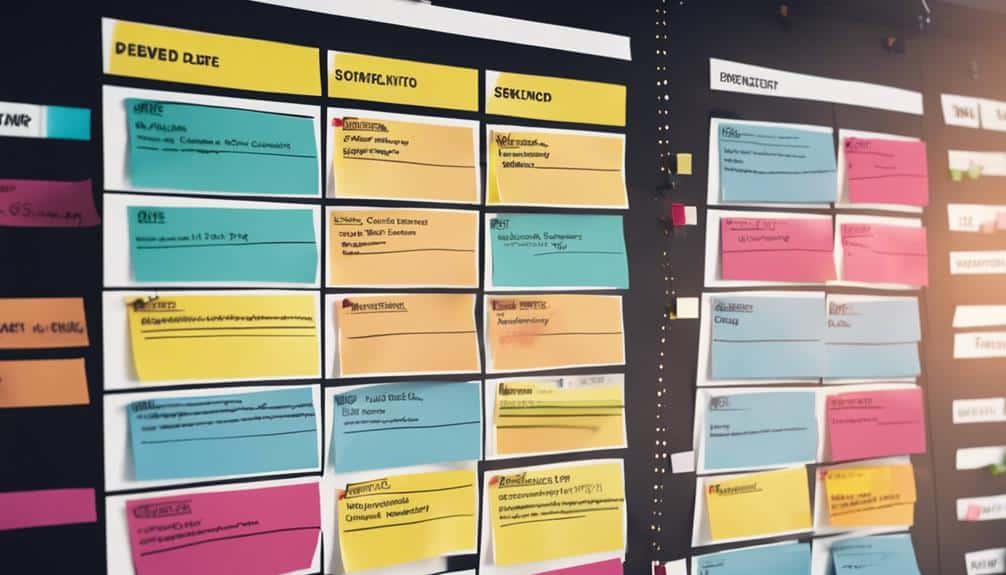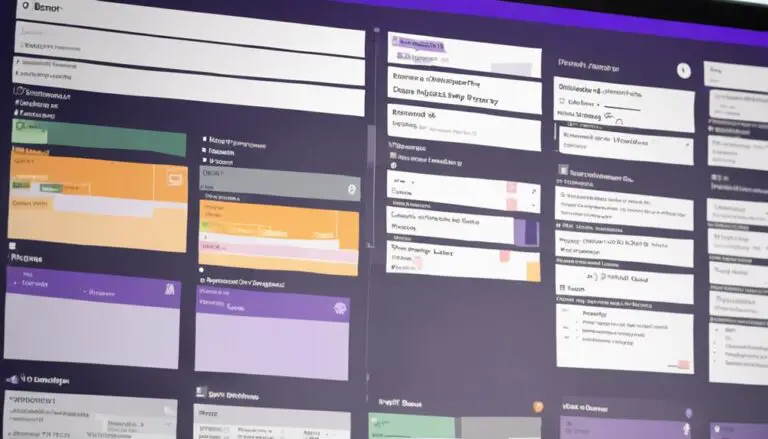So, you think Kanban and sprints don't mix? Think again. By merging the flexibility of Kanban with the structured cadence of sprints, your team can achieve a harmonious balance that boosts productivity and efficiency.
But how exactly can you navigate this integration successfully? Let's explore some key strategies that will help you seamlessly incorporate sprints into your Kanban workflow, ensuring a dynamic and streamlined process that maximizes your team's potential.
Key Takeaways
- Combine Kanban for workflow visualization and Sprints for task breakdown
- Improve productivity with focused tasks and enhanced visibility
- Achieve incremental delivery and efficient prioritization
- Ensure structured project delivery through balanced frameworks
Understanding Kanban and Sprints
By visualizing workflow and limiting work in progress, Kanban teams effectively incorporate sprints to enhance task management and productivity. Kanban, with its focus on visualizing workflow, provides a clear overview of tasks at hand, making it easier for teams to identify bottlenecks and streamline their processes. On the other hand, sprints, as time-boxed iterations, help break down tasks into manageable chunks, allowing for a more structured approach to completing work.
When Kanban teams integrate sprints into their workflow, they can set specific time limits for tasks within their Kanban boards. This approach not only adds a sense of urgency to completing tasks but also ensures a steady flow of work without overwhelming team members. By combining the flexibility of Kanban with the structured nature of sprints, teams can achieve a balance between adaptability and predictability in their task management.
Benefits of Combining Kanban and Sprints
When you combine Kanban and Sprints, you'll notice increased productivity as tasks become more focused and workflow visibility improves.
It's a great way to enhance your team's performance and stay on track with your goals.
Together, these methods can help you prioritize efficiently and deliver results predictably.
Increased Productivity With Kanban
Boost your team's productivity significantly by combining Kanban with Sprints, creating a dynamic framework for efficient task completion. Here are four ways this combination enhances productivity:
- Enhanced Task Prioritization: Kanban's visual workflow management complements Sprints, helping you prioritize tasks effectively.
- Promotes Incremental Delivery: Integrating Kanban with Sprints encourages continuous improvement by delivering work in small, manageable increments.
- Improved Collaboration: Kanban boards in Sprints facilitate better task visualization, tracking, and collaboration among team members.
- Balanced Structure: By incorporating Sprints in Kanban teams, you strike a balance between flexibility and structure, leading to more efficient project delivery.
Embrace this powerful combination to elevate your team's productivity and achieve your project goals effectively.
Improved Focus on Tasks
Combining Kanban with sprints sharpens your team's focus by establishing specific time frames for task completion, enhancing efficiency and productivity. Sprint Planning with Kanban allows Scrum Teams to define and prioritize product backlog items within manageable iterations. By breaking down work into smaller segments, teams can better manage work items and ensure tasks are completed within the sprint duration.
Kanban boards provide a visual representation of tasks, aiding in task prioritization and tracking progress. This structured approach not only improves task visibility but also fosters accountability within the team. With sprints, Kanban teams can align their efforts towards common goals, leading to enhanced collaboration and a sense of achievement.
Enhanced Workflow Visibility
To better understand the benefits of incorporating Sprints into your Kanban workflow, consider how this integration enhances visibility into your team's progress through visual representations on Kanban boards. Here are four ways in which combining Kanban and Sprints improves workflow visibility:
- Clear Task Prioritization: Visualizing tasks on Kanban boards helps in understanding what needs to be done first.
- Defined Time Boundaries: Setting time boundaries with Sprints allows for better tracking of work progress.
- Enhanced Team Collaboration: Kanban and Sprints promote collaboration by making work visible to the entire team.
- Structured Approach: The combination provides a structured method for managing tasks while encouraging adaptability within the team.
Implementing Sprint Planning in Kanban
Let's talk about how you can bring clarity to your sprint duration, foster team commitment to sprints, and continuously improve your sprints within Kanban.
Setting specific timeframes for task completion in each sprint can help your team stay focused and on track.
Sprint Duration Clarity
For greater clarity in Kanban teams, establishing specific timeframes for task completion within each Sprint is crucial. Here are four key points to consider when focusing on Sprint duration clarity:
- Setting Clear Deadlines: Define the duration of each Sprint to create a sense of urgency and commitment.
- Enhancing Task Prioritization: By having a clear timeline, teams can better prioritize their work effectively.
- Improving Focus: Clear Sprint durations help in maintaining focused efforts towards completing tasks within the set timeframe.
- Ensuring Value Delivery: Establishing specific timeframes ensures that the team delivers value consistently and predictably.
Team Commitment to Sprints
Encouraging team alignment and fostering a culture of collective ownership, implementing Sprint Planning in Kanban cultivates a shared commitment to achieving specific, time-bound objectives. By committing to Sprint Planning, teams prioritize tasks based on capacity, ensuring focused efforts towards timely completion.
Collaboration flourishes as team members work together to define Sprint goals and hold each other accountable for their contributions. This shared commitment not only enhances productivity but also strengthens team cohesion.
Embracing Sprint Planning in Kanban instills a sense of responsibility towards achieving Sprint objectives collectively. Through effective planning and clear prioritization, teams can navigate Sprint durations with purpose and determination, driving continuous improvement in their workflow.
Continuous Improvement in Sprints
To further enhance your team's effectiveness and adaptability within Kanban, integrating Sprint Planning not only prioritizes tasks but also fosters continuous improvement in sprints.
Here are four key aspects to consider for continuous improvement in sprints within Kanban:
- Refining the Sprint Backlog: Regularly review and adjust the sprint backlog to ensure it aligns with the team's capacity and priorities.
- Adjusting Priorities: Be flexible in reordering tasks based on changing requirements or insights gained during the sprint.
- Maximizing Flow Efficiency: Focus on maintaining a smooth workflow to enhance productivity and minimize bottlenecks.
- Adapting to Changes: Embrace adaptability by responding to unexpected challenges and incorporating feedback for iterative improvements.
Enhancing Collaboration With Sprints
Incorporating sprints within Kanban methodology fosters enhanced collaboration among team members, leading to more streamlined workflows and improved outcomes. By embracing sprints, you create a framework that not only enhances productivity but also nurtures a sense of togetherness within your team. Incorporating sprints in kanban allows for a more structured and organized approach to task completion. It also encourages team members to work closely together towards common goals, resulting in a tangible impact on the overall success of the project. Additionally, the use of sprints within the kanban methodology provides a clear timeframe for achieving objectives, helping to keep the team focused and motivated.
The structured cadence of sprints allows for regular check-ins, promoting progress tracking and course correction when needed. This collaborative approach empowers everyone to work towards common objectives, fostering a shared sense of achievement. Moreover, the adaptability offered by sprints enables your team to review and refine processes efficiently, striking a balance between flexibility and predictability in workflow management.
Embracing sprints not only boosts individual productivity but also strengthens the collective effectiveness of your team. By working together through sprints, you can leverage each other's strengths, support one another through challenges, and celebrate successes as a united team.
Optimizing Workflow With Kanban Sprints
Optimize your team's workflow effectively by harnessing the power of Kanban Sprints to streamline work processes and achieve timely task completion. When incorporating Sprints into your Kanban system, you can enhance productivity and maintain a steady workflow pace by focusing on time-bound delivery of work items.
Here are some key ways Kanban Sprints can help optimize your workflow:
- Clear Priorities: Sprints in Kanban allow your team to set clear priorities for each iteration, ensuring everyone is aligned on what needs to be accomplished.
- Enhanced Productivity: By breaking work into manageable chunks within Sprints, your team can improve productivity and achieve tasks efficiently.
- Predictable Workflow: Kanban Sprints enable you to establish deadlines for completing tasks, leading to a more predictable workflow and timely delivery.
- Continuous Improvement: Through iterative planning and review cycles, Kanban Sprints facilitate continuous improvement in your task management processes, fostering adaptability and growth.
Overcoming Challenges in Sprint Integration
Overcoming challenges in integrating sprints within Kanban teams requires a concerted effort to address resistance and provide necessary support for seamless transition. It's normal for team members to feel hesitant about changes, but highlighting the benefits of sprint integration can help alleviate concerns.
Offering training sessions to explain how sprints enhance workflow in Kanban and aligning sprint goals with Kanban principles are crucial steps in this process. By managing the transition phase carefully and minimizing disruptions, productivity can be maintained during integration.
Encouraging open communication and feedback loops is also essential to address any challenges that may arise and optimize the effectiveness of sprint integration in Kanban teams. Remember, everyone is part of this journey towards workflow enhancement, and by working together and being open to change, the team can successfully overcome any obstacles in sprint integration within the Kanban framework.
Best Practices for Kanban Sprint Success
To achieve success with Kanban sprints, prioritize clear communication and collaborative goal-setting among team members. When working with Kanban boards and integrating sprints, follow these best practices for optimal outcomes:
- Utilize Sprint Planning: Engage in detailed sessions to refine backlogs, define tasks, and set WIP limits for a streamlined workflow.
- Maintain Alignment on Kanban Board: Prioritize work items according to Sprint goals to ensure focus and progress tracking.
- Conduct Regular Sprint Reviews: Evaluate performance, gather feedback, and make necessary adjustments to enhance delivery predictability.
- Embrace Retrospectives: Reflect on processes, celebrate achievements, and collaboratively identify areas for improvement within the team.
Frequently Asked Questions
Can You Do Sprints With Kanban?
You can definitely do sprints with Kanban! They enhance sprint efficiency, Kanban adaptation, and agile integration. Enjoy improved team productivity, sprint cadence, Kanban flexibility, and valuable sprint metrics for a successful collaboration journey.
How Do I Manage Sprints in Kanban Board?
To manage sprints in a Kanban board effectively, start by setting clear sprint goals during planning. Prioritize tasks, hold daily standups, track cycle time, collaborate with the team, and focus on continuous improvement while addressing any blocked tasks promptly.
What Is the Sprint Goal in Kanban?
In Kanban, the Sprint Goal is a clear objective set for each Sprint. It directs your work, aligns tasks with the goal, and guides prioritization. Adjust as needed for changing needs. Keep focus on Sprint success.
How Do Scrum and Kanban Work Together?
You can enhance team collaboration and efficiency by integrating Scrum with Kanban. Embrace Agile methodology through Scrum integration for sprint planning, visual workflow, and continuous improvement. Lean principles combined provide clarity and adaptability for effective project management.
Conclusion
So there you have it, incorporating sprints into your Kanban process can be a game-changer for your team.
Who would've thought that combining these two methodologies could lead to such great results?
Keep collaborating, adapting, and optimizing your workflow with Kanban sprints, and watch your team soar to new heights.
Embrace the irony of how something so simple can make such a big impact.
Happy sprinting!





